Zoning laws have led to a segregated Hamden
Activists are working to fix it
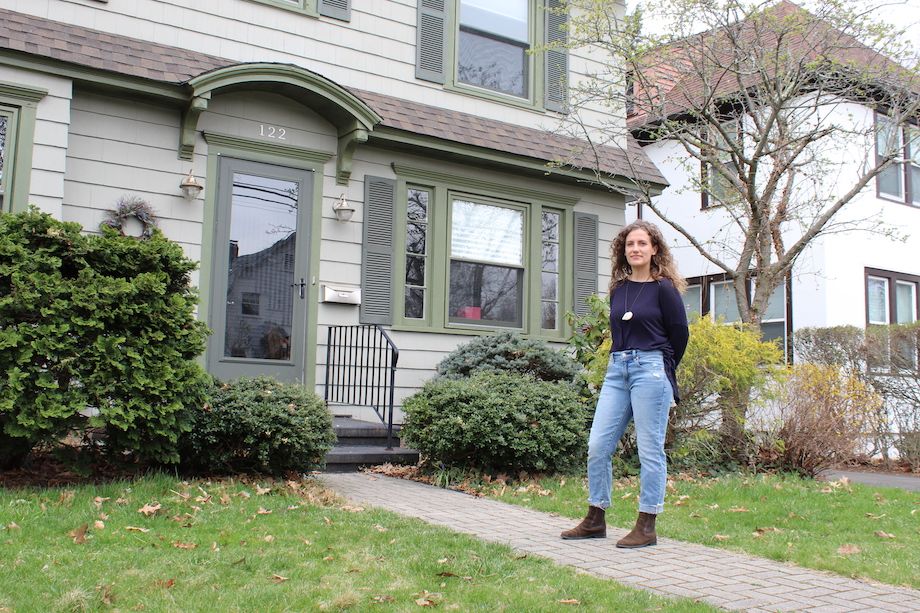
Marissa Dionne Mead moved to Hamden’s Spring Glen neighborhood five years ago after spending the first part of her life living in cities like New Haven. The suburbs were new to her, but now that she had kids, it seemed like the right place to settle down.
When George Floyd was murdered by police in Minneapolis in May 2020, her neighborhood — while predominantly white — united around the Black Lives Matter movement.
“Folks were online, coordinating purchasing yard signs,” Mead said. “We as a neighborhood bought hundreds of signs and put them up all over our neighborhood.”
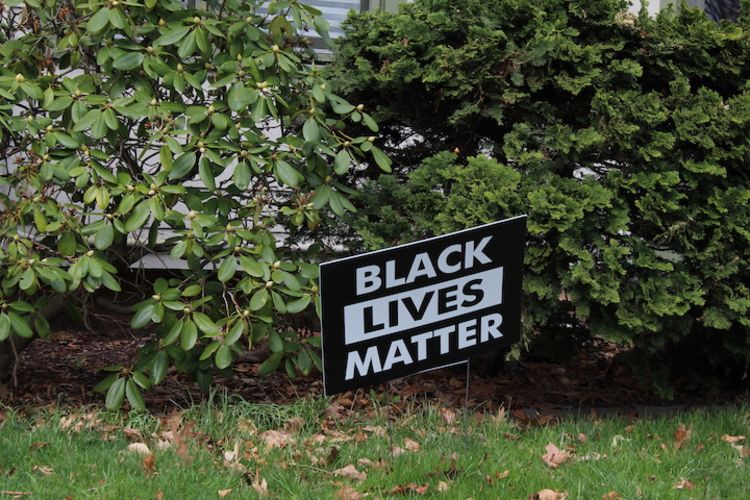
This sign sits in Mead’s front yard. (Photo by Emily DiSalvo)
This sign sits in Mead’s front yard. (Photo by Emily DiSalvo)
But Mead was startled when, days later, the same people who were coordinating the purchase of yard signs took to Facebook to protest a new multifamily housing development on the edge of Spring Glen.
“It would bring a different scale of housing, a different size,” Mead said. “With diverse housing types come diverse populations in age, race and economics. To me, and to some others, it seemed like there was a disconnect between what we were saying we were supporting by putting these signs in our yards and what we were actually as a neighborhood doing — trying to prevent diversity.”
Meanwhile at town hall, Brad Macdowall was still relatively new to his position on the Hamden Legislative Council. He had been serving since 2017, when in 2020, Hamden zoning codes prevented Wes Fortier from opening a tattoo parlor in northern Hamden. This was the first time Macdowall saw the dark side of outdated zoning laws.
Fortier grew up in Hamden and hoped to open his tattoo shop near the place he calls home.
“It’s not fair that we have 30 bars and 30 liquor stores and this stuff is everywhere, but tattoo was considered an ‘adult service,’” Fortier said. “If I did want to open, I could only do it under special permission from the town in a manufacturing zone, which would basically put me in an industrial park. The way the regulations were written were done to keep us out of public view.”
The town approved the decision to zone tattoo parlors as “adult oriented establishments” alongside places like strip clubs and sex shops as recently as 2017. However, Fortier’s problem drew attention to the fact that it wasn’t just tattoo parlors that the restrictive zoning codes targeted.
“It was rap studios, female impersonator shows,” Macdowall said. “You could open a rock studio or another music studio anywhere in town, but if you are producing rap? These are obvious examples of discrimination on the basis of gender identity and race.”
Fortier took his complaints to Facebook. He started getting calls from town officials, one of whom was Macdowall. On the phone Fortier emphasized that he wanted this policy changed for everyone, not just him. While he said he couldn’t be sure of anything, the intent of the regulations seemed racist.
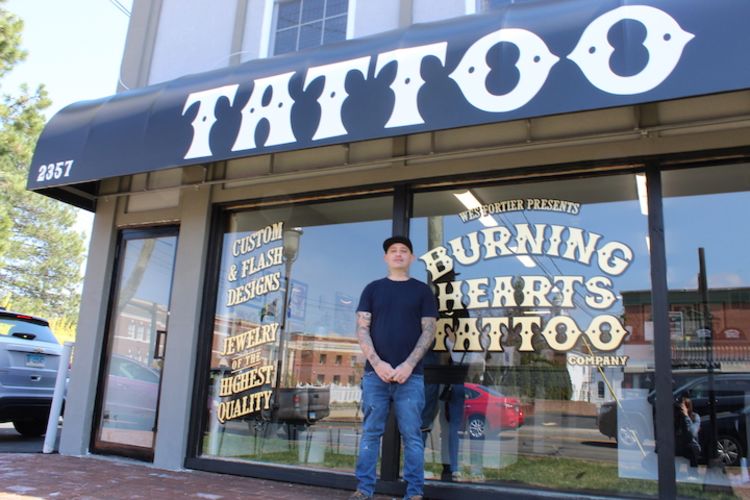
Wes Fortier uncovered some of Hamden’s outdated zoning regulations when trying to open his tattoo parlor. (Photo by Emily DiSalvo)
Wes Fortier uncovered some of Hamden’s outdated zoning regulations when trying to open his tattoo parlor. (Photo by Emily DiSalvo)
“I can’t imagine another reason to say ‘rap’ studios instead of ‘recording’ studios,” Fortier said. “It was odd — I said it out loud to one of the people I was talking to. I was like, ‘You realize rappers go to a recording studio not a rap studio, right.’ This is wrong.”
Macdowall said that the Planning and Zoning Commission did update this regulation after the tattoo parlor brought the problem to light. He said that while most explicitly racist aspects of the zoning codes have been changed, remnants of racist zoning and redlining have left an impact on the town.
“So long as those (remnants) exist we will not be able to rectify the situations we have created,” Macdowall said.
White activists and elected officials like Macdowall and community members like Mead came to the realization that some zoning laws in Hamden were written to keep certain communities out of particular areas of town resulting in the segregated Hamden that still exists today.
But for Black people living in Hamden, this realization is already a part of daily life.
“We know that segregation is illegal,” said Rhonda Caldwell, lead organizer for Hamden Action Now. “The things that impact real estate in our communities are obvious and apparent but you can’t prove it because it’s not legal so you can’t call it that. When I say there is segregation in Hamden, well the data says that Black people mostly live down in Newhall and the third voting district — segregation doesn’t mean what it used to.”
To the south in the Newhallville neighborhood of Hamden, another member of the legislative council, Justin Farmer, grew up in circumstances much different than Macdowall’s. Farmer is Black. He learned about why his neighborhood was different from Spring Glen long before the tattoo parlor brought the situation to light for Macdowall.
Farmer explained that Hamden is the product of New Haven’s white flight, which began in the 1950s. When white people fled New Haven and its increasing population of people of color, they settled in places like Spring Glen.
In order to keep these neighborhoods as white safe havens, many of the documents and deeds associated with these homes contain language indicating that “no persons of any race other than the white race shall use or occupy any building on any lot…except by domestic servants” — a Jim Crow custom.
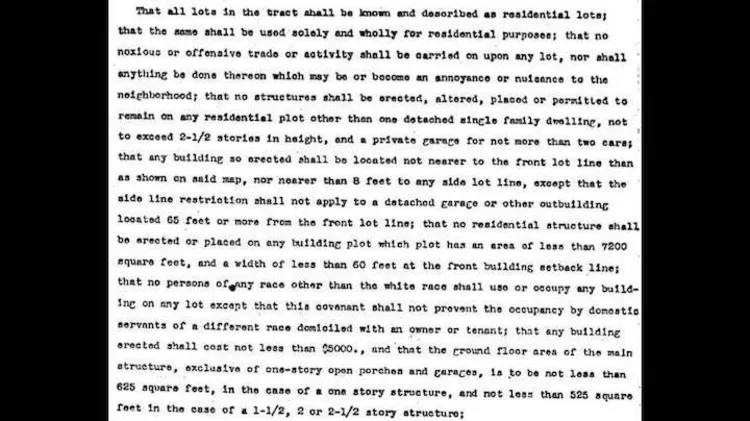
This deed from a Spring Glen property states that only white people can live there. (Courtesy of Spring Forward Spring Glen)
This deed from a Spring Glen property states that only white people can live there. (Courtesy of Spring Forward Spring Glen)
The historical legacy of “redlining,” or government denial of mortgages and other services on the basis of race, led to many Black people settling together in the areas where they could get a loan. These locations were often less desirable than zones not contained in redlining.
Since many families in Hamden choose to pass their home down to future generations, the pattern of whiteness has remained in many neighborhoods, even as Jim Crow is in the past.
“It has a great level of homogeneity from its conception, so you can see that people moving into your community, who don’t have as deep of roots, who don’t look like you, play into tensions around zoning, housing and employment,” Farmer said.
As a 27-year-old Black man, Tyrese Ford said he’d have to consider his comfort level before deciding if he could go to Spring Glen.

Tyrese Ford, 27, is a lifelong resident of Hamden. (Photo from Tyrese Ford)
Tyrese Ford, 27, is a lifelong resident of Hamden. (Photo from Tyrese Ford)
Would I feel comfortable going to Spring Glen, myself as a Black man and see everyone there not look like me?” said Ford, a lifelong resident of the Whitneyville neighborhood. “I haven’t really gone to Spring Glen just to hang out and I think that in and of itself says quite a lot about the neighborhood and my perception of it. I never had a reason to even though I had friends in that area.”
Caldwell, who is Black, used to live in Spring Glen several years ago.
She noted that segregation today is not coming from redlining but from the way homes in Spring Glen stay in the families, passed down from white family member to white family member.
“In order to maintain segregation and a living in a segregated community, (white people) are willing to pay a premium for real estate to be able to get that level of exclusivity,” Caldwell said.
These were some of the same tensions that led Spring Glen residents to protest the new development on the edge of their neighborhood. Caldwell said critics may encourage people of color to simply “buy a house in Spring Glen” to help reduce segregation but said the answer isn’t this easy.
“I hear people say, ‘That’s a nice community, that’s a coveted community,’” Caldwell said. “People are willing to pay. If there is a high demand for that supply of housing then the prices go up. If the demand is high because of the exclusivity of the whiteness, that is going to drive the price up.”
Caldwell pointed out that the goal of changing zoning is to bring diversity so it would make sense that white people who paid a premium to live in a white neighborhood would protest movements to diversify.
“I lived in Spring Glen, I probably wouldn’t live there again,” Caldwell, who now lives near the Bear Path School, said. “It’s pretty isolating of a community. It’s intentional. The community for decades, since it was created in the 1920s, was built for white families.”
History of Hamden
While Newhallville used to be a German community in the 1900s and an Italian community in the 1950s, now most of the families are Black.
“It is zoned in a weird way because there used to be a lot of factories here and factory jobs were very important in a lot of ways,” Farmer said.
Over time, a trolley — which ran up and down Whitney Avenue — stopped its service and the town replaced it with a road. People with cars moved north into Hamden when factory jobs became scarce, leaving behind a community of people without cars or jobs.

This map shows the trolley route to Spring Glen Estates. (Courtesy of Hamden Historical Society)
This map shows the trolley route to Spring Glen Estates. (Courtesy of Hamden Historical Society)
The neighborhood that remained was a mixture of industrial and residential zoning built on a “brownfield,” meaning its soil contains toxic contaminants.
“Knowing that it was toxic, (the industrial companies) sold it to Black and brown community members, and in this community since I have been here, 20 of my 26 years of life, there’s been 18 or 19 houses that have sunken into the ground,” Farmer said. “My childhood home, which was across the street from the house I live in now, actually sunk into the ground.”
Nowadays, before land is sold, the person selling it must disclose any issues with the property. That was not the case when Farmer’s family and others moved in.
“If I sold a community bad goods on purpose? Imagine today people found out you sold me a house with problems and I paid more than the value of it, so now I am underwater and even if I can get someone to sell it, I have to disclose the problems with it or else I am liable,” Farmer said. “That justice wasn’t served to many people in this community.”
Because Newhallville is a brownfield, it now has a zoning overlay labeling it as such. Spring Glen, the white neighborhood where Mead lives that resisted multifamily housing, also has an overlay, but for a different purpose.
“The Spring Glen village has certain specifications on how houses had to be built and had to look and be kept and maintained to prevent certain people from moving into the community,” Farmer said.
The Spring Glen Civic Association drafted the overlay and the town adopted a revised version in 2009 as a reaction to proposals for development along Whitney Avenue.
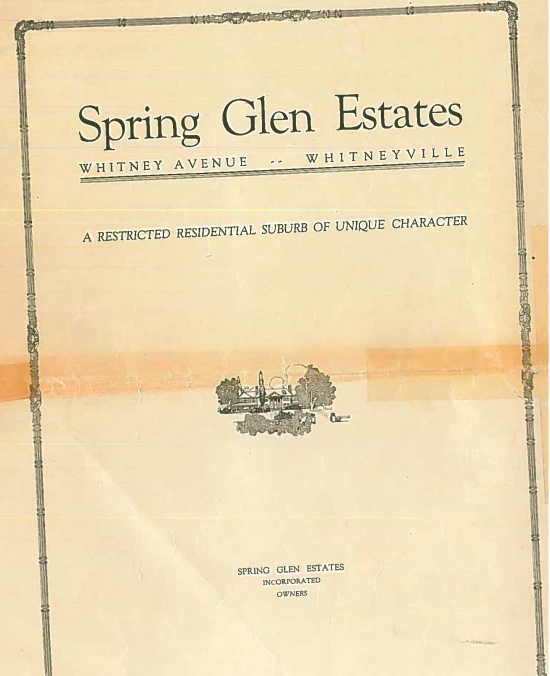
This brochure from Spring Glen from 1922 labels it, “a restricted residential suburb of unique character.” (Courtesy of Hamden Historical Society)
This brochure from Spring Glen from 1922 labels it, “a restricted residential suburb of unique character.” (Courtesy of Hamden Historical Society)
Leslie Crean, who served as the town planner in Hamden from 2003 to 2015, said her attempts to overhaul the zoning codes were thwarted by neighborhoods like Spring Glen that did not want anything to change.
“There is often a knee-jerk reaction by people who are afraid of change, or don’t understand, or who aren’t taking the time to look or don’t have the time to get together with neighbors to figure out what they want,” Crean said.
The first few drafts of the overlay created by the Civic Association were “patently not legal,” according to Crean. The suggestions the residents compiled were revised so they were legal and approved.
“If there is a resistance to change it means that on some level you are accepting what is existing,” Crean said. “Who does that benefit and who doesn’t that benefit?”
What is meant by ‘character’?
When Jay Kaye of Spring Glen and former mayoral candidate first learned about the overlay that applied to the land in his neighborhood, he assumed it was an aesthetic decision to keep the architecture in the area consistent.
“I could see you wouldn’t want to build a shiny glass building because it doesn’t match the architectural character of the neighborhood,” Kaye said. “It is kind of a village style. That would make sense. But it was seeming like it was preventing even a village style of development.”
The overlay reads, “The purpose and intent of the Spring Glen Village District Regulations is to protect the unique character of Spring Glen, which is a primarily residential neighborhood…”
Kaye realized, after speaking with activists like Mead, that “character” was not referring to architectural character.
“I can’t necessarily say the intent of using those words,” Kaye said. “Maybe at the time it was ‘We don’t want a lot of traffic. It will be too busy.’ But it just seems more recently the term ‘character’ has come under question. I wouldn’t want to suggest that they were trying to keep people of color or a certain economic status out. I just think they are a little protective of their neighborhood. But one of the effects of protection is that it is exclusionary.”
While other areas of town don’t have overlays like Spring Glen, the history of redlining in Hamden has contributed to the segregation of many other neighborhoods.
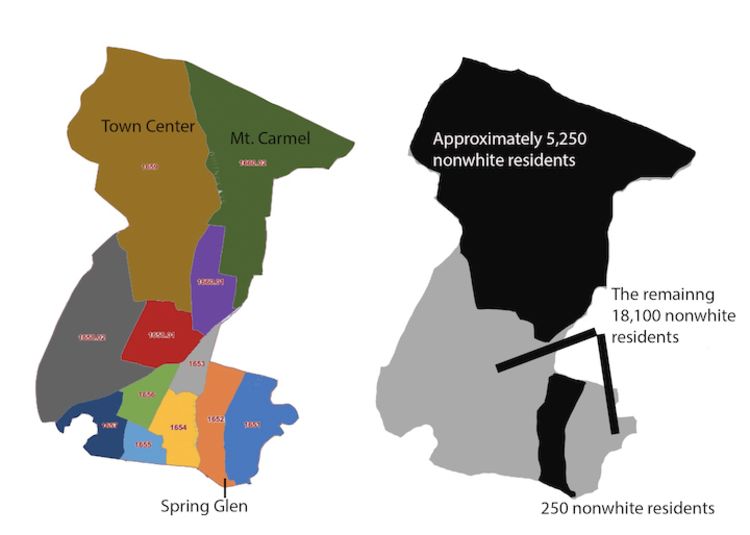
This map shows that the non-white communities in Hamden are concentrated to the south. (Graphic by Emily DiSalvo)
This map shows that the non-white communities in Hamden are concentrated to the south. (Graphic by Emily DiSalvo)
Betsy Rosenblum of the Westwoods neighborhood said she never had people of color as neighbors, until this year when a Black family moved in next door. Rosenblum, a professor at Quinnipiac University, has lived in Hamden 63 out of her 66 years and during that time said she has made many observations about differences between neighborhoods.
“Hamden has always been a highly segregated town,” Rosenblum said. “…It just seems like there are more people of color living in southern Hamden than in northern Hamden.”
While she said Westwoods in northern Hamden has become slightly more diverse in recent years, the changes are minute, such as her new neighbors.
“Redlining and zoning laws are not in the best interest of people of color in the town of Hamden,” Rosenblum said.
The part of the zoning code that Crean eventually overhauled was allowing for some mixed zoning areas where both businesses and residential areas coexist.
“Although it was not done with racial segregation in mind, it was about looking to allow different things in different areas,” Crean said.
She explained that these changes can lead to mixed-use structures, such as a building that has both housing and a commercial space.
“You can have the possibility of someone owning a building and renting an apartment there too,” she said.
Crean said the differences between the neighborhoods in Hamden are very apparent. However, she said her role as town planner was about setting the town up for success, not forcing people to integrate.
“Planning is setting the table,” Crean said. “You make the rules that allow things to happen and there’s the rule of economic development, you encourage people to create their own businesses. Allowing things where they weren’t allowed before.”
The majority of zoning districts in Hamden that allow for three or more families to live together are in the southern portion of town. Fifty five percent of homes in town are zoned for only one family, and a one-family home is an expense many families cannot afford.
While the days of redlining have passed and efforts by people like Crean have made some differences, many of the scars of the past remain. In Farmer’s neighborhood, it is hard to find a store to buy food anywhere in the area. The one store that sells groceries is “Save-a-lot.”
“(Save-a-lot) is a recycled grocer,” Farmer said. “They literally take produce from other grocery stores and resell it. You might buy fruits and vegetables and they may only last three or four days before they go bad. With the exception of that, in a 3.5 mile radius, there is no grocery store in this part of town — going on almost 15 years now.”
Ford lives in Whitneyville which he said is a racially and socioeconomically diverse place that “treated him well” for the past 27 years. As he begins to consider where he may want to start a family, he said which neighborhood he chooses to settle in matters.
“I am thinking about having a family and raising children and one of the questions is ‘How are my neighbors going to influence my child’s life and my child’s respect of all life?’” Ford said. “Are they actually going to experience diversity in their neighborhood?”

Tyrese Ford at Sleeping Giant State Park in Hamden (Photo from Tyrese Ford)
Tyrese Ford at Sleeping Giant State Park in Hamden (Photo from Tyrese Ford)
When Rosenblum drives from northern Hamden to southern Hamden, she said she can see the differences in what is accessible to her versus residents like Farmer.
“Southern Hamden is a food desert,” Rosenblum said. “They used to have a Super Stop and Shop but they no longer have that. It has forced the Walgreens in southern Hamden to carry more grocery items to accommodate people in southern Hamden.”
As a result, many people from southern Hamden come up to central Hamden to go to the Stop and Shop on Dixwell Avenue, which Rosenblum said causes some anger for some northern Hamden residents.
“It is just abundantly clear that northern Hamden, Westwoods, has some serious racist flaws,” Rosenblum said.
In the last several years, many of the remaining factories in southern Hamden have shut down. While Farmer hoped they would become businesses that could create jobs, they all became churches.
“You have jobs and commerce here and instead of coming up with ideas on how to bring back opportunities and development, these gigantic factory buildings are churches,” Farmer said.
The churches include Bread of Life and Breakthrough Church. Additionally, the U.S. Mail sorting center in the area became a church.
Both Rosenblum in the north and Farmer in the south have connected the dots between Hamden’s segregation and its crime problem. According to Neighborhood Scout, the chances of becoming the victim of a property crime are one in 46 in Hamden as opposed to one in 70 in Connecticut as a whole.
“If you overlay the red lines with crime rates to see where the most crime is in different communities across the country, you will see most of the crime is where we segregated Black and brown people to be,” Farmer said.
“If you overlay the red lines with crime rates to see where the most crime is in different communities across the country, you will see most of the crime is where we segregated Black and brown people to be”
Justin Farmer
Hamden Legislative Council
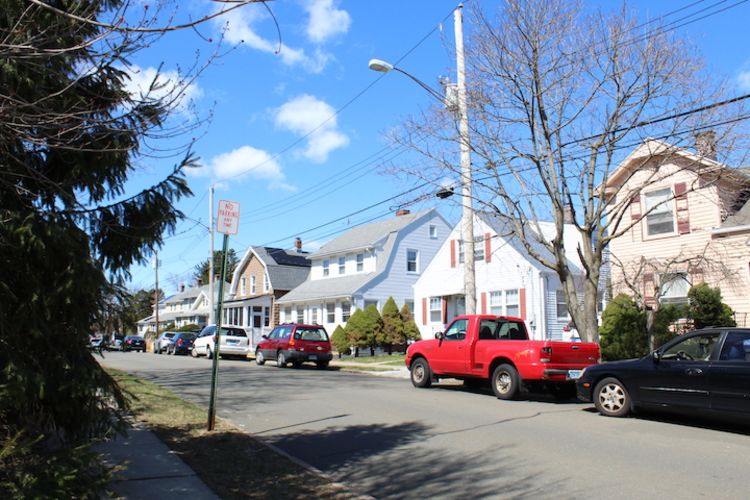
Farmer said the zoning codes that kept Black people segregated to neighborhoods without resources, leading to crime was intentional on the part of white lawmakers. He suggests that any Hamden resident upset about the rise in crime should advocate investing in communities like his because that will decrease the need for police services.
Rosenblum said she hears other Hamden residents complain about people from southern Hamden coming up to northern Hamden to “commit crimes.” She called this “racist” and said people should look to where crimes start before casting judgements on those who commit them.
“Can we look at the root of why crimes are committed and can we get to the root of the problem instead of just spitting them back out to commit more crimes?” Rosenblum said. “Housing and zoning are heavily related to all of these things.”
While Rosenblum said none of these issues fall neatly on party lines, she noted that her neighborhood tends to lean toward the Republican Party and also tends to be less open to changing zoning laws to dismantle racism. Kaye is a member of the Republican Party and he said he is disappointed with how some of his fellow Republicans address this issue.
“My whole take on it is, this is America,” Kaye said. “We stand up for American principles and capitalism and economic growth and freedom for all, and if there are policies that are restrictive to a certain segment of Americans that are not able to participate in equal opportunities, then you are being a little hypocritical. If you are going to say all Americans deserve the pursuit of happiness and there are policies that prevent that, then you are going to want to take a stand against these policies.”
A movement of zoning activism
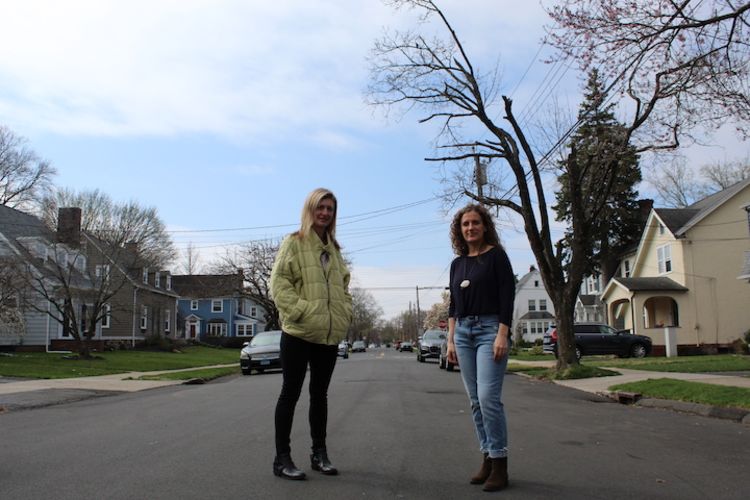
Marissa Dionne Mead and Danielle Chapman of Spring Forward (Photo by Emily DiSalvo)
Marissa Dionne Mead and Danielle Chapman of Spring Forward (Photo by Emily DiSalvo)
Mead recognized the same hypocrisy as Kaye. Black Lives Matter signs directly contradict movements to prevent housing developments. Fighting zoning reform contradicts American principles of equality. Both work against diversifying a segregated town, and a segregated state.
Spring Forward Spring Glen is a grassroots organization spearheaded by Mead and another Spring Glen resident hoping to bring awareness to zoning problems in Hamden and the issues with the overlay on their neighborhood.
This movement is hyper-local, but a larger movement in Connecticut to pass bills that would change town zoning codes across the state is making legislative progress this session.
“I found myself online trying to debunk arguments against the new development and connecting with other folks I knew and somebody that I connected with, Danielle Chapman, another mom in the neighborhood — she and I decided to harness that energy,” Mead said.
Both Mead and Chapman moved to the area recently, without realizing the demographics.
“It became more clear about the lack of diversity and the more we started to talk about it and learn about it we realized it wasn’t by accident,” Mead said. “We have this realization, we moved here, white families into this neighborhood, and our choices and the things we have done have not helped the situation of segregation. What can we do now that we know?”
Spring Forward is now a Facebook group with about 150 members. Mead and Chapman researched the history of zoning in town, while supporting existing groups advocating for housing equity.
“As a majority white neighborhood it’s on us to educate ourselves so we can go out there and be supportive to minority-led efforts,” Mead said.
The group developed a powerpoint presentation to educate members of the community on the problem and ways in which they hope to solve it. The four steps they outline are zoning, development, advocacy and outreach. As someone who previously lived in diverse neighborhoods, Mead wants others to understand why diversity matters.
“It’s history and zoning and regulations and laws, so at face value it doesn’t seem that exciting,” Mead said. “But when we condense down that information into a 30-minute presentation with the visuals, it is a lot of information people are surprised by. It came from the top down all the way to the local. Seeing how pervasive the discrimination was can be eye-opening for people.”
Ford, a member of the Spring Forward Facebook group, said he’s impressed with Hamden’s efforts to right some of the wrongs of the past and called zoning reform “one step” in the right direction. But he also urged other towns in New Haven County to join the movement.
“I appreciate Hamden a lot for increasing its use of affordable housing all throughout Dixwell,” Ford said. “It is doing a lot for the community at large and what I mean by community at large is New Haven County. But we need other towns to step up. We need Woodbridge to step up. We need Cheshire to step up — they need to change their zoning laws so we can have affordable housing in all of New Haven County. It shouldn’t be concentrated in the city. All of the surrounding towns benefit.”
Desegregate CT is a non-profit group working to push bills through the Connecticut state legislature to expand access to accessory dwelling units (ADUs) like garage apartments and additions to homes that would make more places for people to live. The group is also trying to shine a light on inequality and segregation in the state.
Sara Bronin, lawyer and wife of the mayor of Hartford, Luke Bronin, founded Desegregate in the wake of racial unrest across the nation in 2020. Kevin Kurian is a policy fellow at Desegregate who joined the group in hopes of making a difference in the state where he grew up.
“Whether we like it or not, Connecticut is a segregated state,” Kurian said. “We see African Americans and other minorities live on less than 10% of our state’s land, mostly confined to our cities.”
Kurian, who grew up in Simsbury, often found himself wondering why he was one of few people of color. Simsbury has a Black, Indigenous, people of color population of 13%, according to Desegregate. Hamden’s BIPOC population is 44%. Simsbury only has one zoning district that allows for three-family houses. The rest are for one-family only.
“It is legitimately a policy choice,” Kurian said. “When you have local zoning regulations that restrict the growth of affordable housing or even market rate housing your town will be less accessible to minority communities.”
One bill drafted by Desegregate is SB 1024, “An act concerning zoning authority, certain design guidelines, qualifications of certain land use officials and certain sewage disposal systems.”
While Kurian did not help to draft the bill, he is currently helping to advocate for it. On April 7, the bill was voted out of committee and will be scheduled for consideration in the House.
“The framework that we are operating under is that we strongly believe that local governments are important and we respect their right to determine what is best for their town and constituents,” Kurian said. “We sought to create a collaborative bill where state and local governments work together.”
The bill will first make it easier for towns to allow for the construction of ADUs. These are a quick way for towns to create more places for people to live in the form of “granny flats.” Kurian said these are often more affordable than other housing options.
“We will create housing for a younger, more diverse community but also for older Nutmeggers that want to stay near their family as well,” Kurian said.
Secondly, the bill will address parking. The bill would place a cap on the number of parking spots that a zoning regulator can force a property owner to create.
In many urban areas, people do not need extensive parking and it only creates burdens for owners. Additionally, paved parking lots contribute to runoff and pollution.
The bill also proposes changing the word “character,” as referenced in the Spring Glen overlay, to mean strictly physical characteristics of buildings.
“Our proposal would ensure “character” is not used against people, but used for the better delineation of the physical nature of our places,” the Desegregate CT website explains.
Erin Boggs is the executive director of the Open Communities Alliance, a civil rights organization trying to integrate Connecticut by making the white suburban areas more diverse and opening up more opportunities for minority communities through legislation and litigation. She said that while SB1024 is a start, the bill championed by Open Communities Alliance, HB6611, will go much further.
“(SB1024) would not have any significant impact on segregation,” Boggs said.
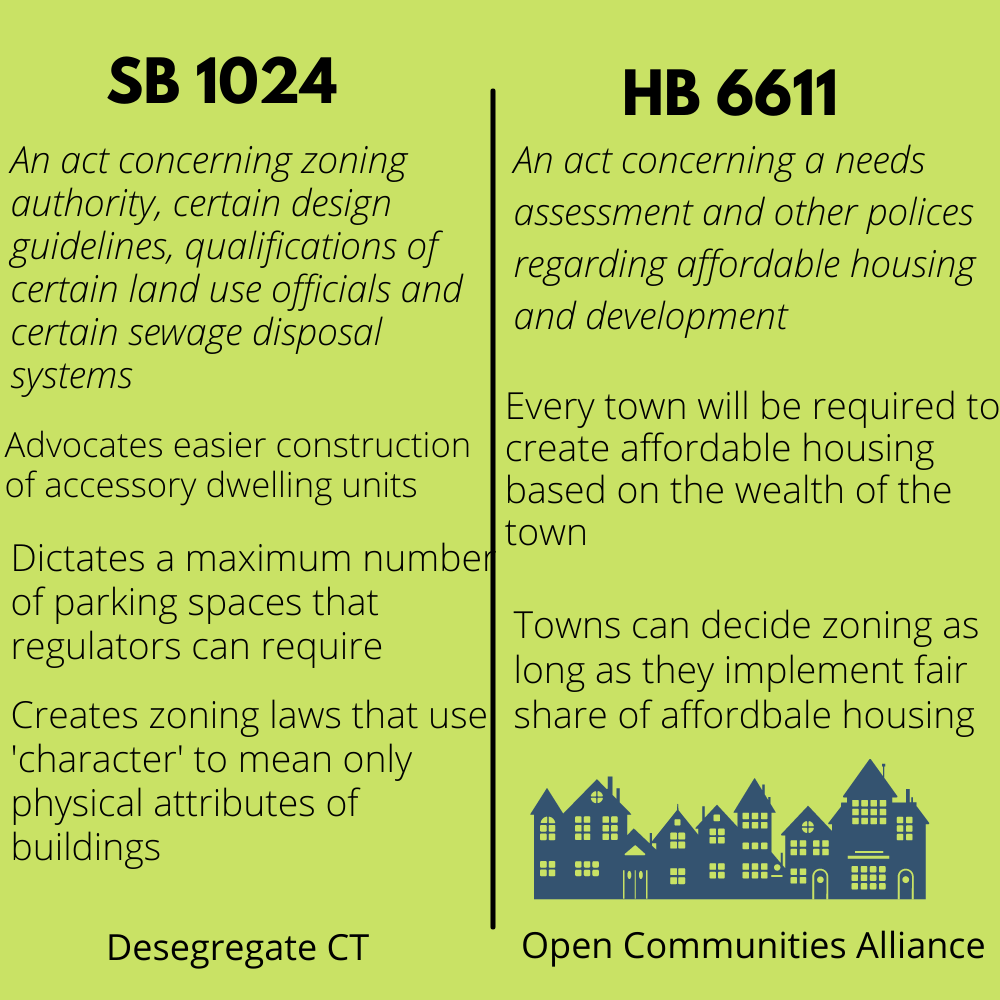
Graphic by Emily DiSalvo
Graphic by Emily DiSalvo
Boggs explained that ADUs would mainly help older white family members of white home owners, rather than families.
“Accessory Dwelling Units are in-law apartments,” Boggs said. “They are not big enough for families with kids and in the bill they are not required to be affordable. They tend to be rented to family and friends. If you are talking about a white community you are talking about most likely a white family member or friend. They are not covered by the Fair Housing Act so you can discriminate.”
HB 6611 has been in the works for five years at the Open Communities Alliance and is modeled after a similar law in New Jersey. The bill would require the state to develop an estimate for the need for affordable housing (135,000 units) and allocate those out to regions and towns. In other words, towns with resources will be given a required number of affordable housing units that they will have to provide in order to meet the need.
“(The wealthier towns) haven’t been doing as much for multifamily housing and creating income diversity in your town, and you have a lot of resources you could be using to do that,” Boggs said.
The bill was filed with the Legislative Commissioners’ Office on April 5 and will then be heard in the Senate.
Caldwell said that while she thinks zoning reform is important, it is only one part of the solution. She encouraged governments, both local and national, to invest in underserved communities rather than trying to relocate families to create diversity.
“A lot of people don’t want to live in Spring Glen,” Caldwell said. “If they grew up in Newhallville and they are second and third generation Newhalville, they don’t want to move to Spring Glen. They want to live in a safe and clean community like everyone else. But these communities need reinvestment.”
With reinvestment can come gentrification so Caldwell stressed that communities try to find a balance in their efforts for reform.
“The minute that a community becomes gentrified it becomes out of the market for the Black and brown community,” Caldwell said. “If Newhallville gets all this investment, white folks are gonna want to move down there before you know it. The demand will go up and so will the prices. Next thing you know, the Black and brown folks who have been living there their whole life can’t afford it anymore.”
Why diversity matters
Local activists like Mead, statewide activists like Kurian and Boggs, and concerned citizens like Rosenblum and Kaye all have one goal in mind — making communities more diverse and integrated. However, they all said that diversity was not about achieving a number but rather about making their communities more inclusive and vibrant places.
“We are helping white communities understand how removed from reality their kid’s experiences are in terms of diversity and that their kids are missing out on an important part of their education, which is gaining the cultural competency in diverse environments,” Boggs said. “That is a skill that will be incredibly important as we get closer to 2042 when we as a country will be majority minority.”
The census reports that by 2045, the number of people who identify as Hispanic, Black, Asian, “multiracial” or other, will outnumber non-Hispanic whites. Studies show that children who grow up in more diverse neighborhoods become more successful as adults in terms of income and education.
Lauren Garrett of the Hamden Democratic Town Committee said that in 2019 the state mandated that Hamden rewrite some of its districts in order to integrate the schools in response to historical segregation.
“It has gotten so out of hand that our only solution here is to change the boundaries for our schools,” Garrett said. “It would be more helpful and more sustainable for us to desegregate our communities and neighborhoods than to change district boundaries every so often because we are not keeping up with affordable housing units going into all of our neighborhoods.”
The neighborhood that the state took issue with was the Church Street School, according to Walter Morton IV, a representative from the Hamden Board of Education. The state flagged the school for having an overwhelmingly non-white population despite representing a diverse neighborhood.
“We are out of balance there because we have too many students of color in one school although it very much looks like the neighborhood in which it is situated,” Morton said.
Morton said there are bigger issues in other neighborhoods. The public school students in Hamden are 65% non-white. Spring Glen School is around 70% white, which Morton said fails to represent the demographics of the district in the same way Church Street School does.
“A school like Spring Glen, where a lot of people, like myself, would say this school does not have the diversity it needs, by the state’s definition and metric, Spring Glen doesn’t make the list,” Morton said. “We are being penalized because there are two few white kids at Church Street when that is a neighborhood that is overwhelmingly residents of color. The schools look like the neighborhood yet that made the hit list.”
Like Rosenblum, Paul Geary, president of the Westwoods Neighborhood Association, said he has seen his neighborhood, which does not have an overlay, become more diverse in recent years.
“Diversity always makes a neighborhood better,” Geary said. “Sometimes you may think something about a certain group of people but it is harder to think those thoughts if those people are your friends and neighbors and you know those people.”
Kurian said it is important to acknowledge that the state of Connecticut hasn’t done its part so far to rectify the past and the time is now to address zoning reform.
“They call us the ‘land of steady habits’ for a reason,” Kurian said of Connecticut. “I hope our zoning system right now is one steady habit that we can kick.”
